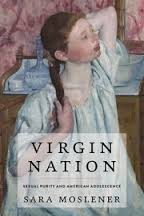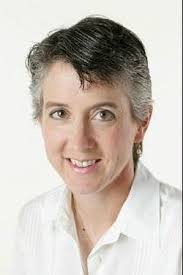 Today’s post is a book review of Virgin Nation: Sexual Purity and American Adolescence
Today’s post is a book review of Virgin Nation: Sexual Purity and American Adolescence, by Sarah Moslener.
The review itself isn’t by me but by someone who actually knows what she’s talking about: Dr. Margaret Kim Peterson, Associate Professor of Theology at Eastern University in Saint Davids, PA.
Peterson’s Ph.D. is in theology and ethics from Duke University, and she also earned an M.A. in Marriage and Family Therapy from La Salle University. With her husband Dwight N. Peterson, she is co-author of Are You Waiting for “The One”?: Cultivating Realistic, Positive Expectations for Christian Marriage. Peterson has been at Eastern since 1998.
********
Remember a few weeks ago, when a story was bouncing around the news about a Republican presidential hopeful Jeb Bush’s past statements about what he saw as a socially damaging decline in public shaming of single parents?
Did anyone stop to wonder what, exactly, might lead a politician trying to appeal to evangelical voters to equate insufficient shame around single parenthood with American cultural decay, and to recommend increased shaming of misbehaving young people as a means of national revival?
If you’re wondering now, there is a book for you: Virgin Nation: Sexual Purity and American Adolescence (Oxford University Press, 2015), by Sara Moslener.
Moslener, who earned a Ph.D. in religious studies at Claremont Graduate University and who now teaches at Central Michigan University, elucidates what she sees as longstanding connections between two strands of evangelical anxiety: worries having to do with the sexual purity of adolescents, and worries about American national well-being.
Anyone who has been around evangelicalism for any time at all is well aware of the emphasis placed within this subculture on “purity,” by which is meant virginity until marriage for both males and females.
Teenagers and young adults are taught to regard purity as an integral—perhaps even as the central—element in their religious identity, and to regard premarital sex with horror and aversion.
In the words of one young person of my own acquaintance: “I was taught that sex before marriage was pretty much the worst possible thing that you could do. I mean, we were taught that murder was very wrong, but obviously we would never do that, so sex before marriage was probably the worst thing we could ever do.”
You might think that parents would be the ones charged with inculcating values—including values around sex and sexuality—in their offspring, but in the present day climate of youth culture and mass media the job of getting adolescents onto the purity bandwagon is increasingly outsourced to faith-based purity organizations.
Two of the most prominent of these are True Love Waits (see also here)–which encourages youth to make publicly spoken commitments to remain sexually abstinent until marriage; and Silver Ring Thing–which is a traveling multimedia show incorporating elements of fantasy and parody to make its case for sexual abstinence, the impossibility of this apart from a personal relationship with Jesus, and the desirability of a symbolically-freighted piece of jewelry—the “silver ring”—that is available for purchase only by attendees of Silver Ring Thing events.
If you think this is all weirdly fascinating enough to be of interest to scholars of American religion and culture, you would be right.
Most scholars trace the rise of the evangelical purity movement to the cultural shifts of the 1960s, with the purity movement originating in response to the loosened sexual mores of that time.
By the 1990s, the time of the emergence of both True Love Waits and Silver Ring Thing, this cultural pushback had been joined by an evangelical desire to embrace certain other aspects of contemporary culture, namely individual choice and self-fulfillment. (Thus both organizations identify a central benefit of premarital sexual abstinence as mind-blowingly fabulous marital sex.)
The contribution of Moslener to this conversation is her sense that the historical narrative needs to start further back, if sense is to be made of certain elements of purity culture rhetoric.
In particular is the explicit use of apocalyptic imagery in connection with sexual morality. Moslener cites a ditty that is performed at Silver Ring Thing events:
The world says use a condom
If we told you you’d be fine / we’d be lying to your face
It’s like playing with a nuclear bomb
You could wipe out the whole human race
The connection between condoms and nuclear holocaust is, as Moslener notes, neither explained or defended by the producers of Silver Ring Thing; it is simply assumed. Why? Exploration of this question forms the substance of Moslener’s book.
Moslener’s sense is that evangelical purity culture (as opposed to traditional Christian emphasis on the reservation of sexual expression to the marital relationship) got its start in the late 19th century, as white evangelicals began to lose their hitherto unquestioned grip on mainstream American culture.
relationship) got its start in the late 19th century, as white evangelicals began to lose their hitherto unquestioned grip on mainstream American culture.
Waves of immigration of non-white, non-Anglo Saxon, non-Protestants threatened to overturn the prior status quo, and white evangelicals responded with a range of social reform movements that privileged bourgeois (read: white, middle-class, Protestant) respectability. Temperance was one such movement; purity was another.
At the same time the psychologist G. Stanley Hall began to identify adolescence as a new stage of human development, one in which young persons grew from innocence into maturity both sexually and spiritually. Later psychologists dropped the religious language that Hall had used to characterize adolescence, but retained Hall’s sense that if anyone was going to save (or ruin) the world, adolescents were.
Hence the focus, Moslener thinks, of the purity movement on specifically adolescent sexuality. It is in the bodies and (sexual) behavior of teenagers that the battle for Anglo-Saxon and specifically American supremacy is being fought.
Moslener traces the development of purity culture from its 19th-century origins through the fundamentalist-modernist controversy of the 1920s, the anticommunism of the Cold War era, and the rise of the family-values movement in the 1970s and 1980s, in which evangelicals drew explicit connections between moral decay and national decline, on the one hand, and strong families and a strong (American) nation on the other.
Later chapters in the book examine True Love Waits and Silver Ring Thing as exemplars of evangelical purity organizations (there are many hundreds of smaller such organizations, but these are the largest two), and looks at the ways in which these are related to political and governmental forces (as for example through the reception or rejection of federal funding for abstinence-only sex education), and ways in which these organizations make use of modern media technologies.
This is a book for scholars. It is a revised dissertation, and reads like one. Phrases like “in an earlier version of this work” pop up from time to time. Academic jargon permeates the book. “Thomas Csordas’s analysis of charismatic healing in the United States is especially helpful for decoding the interplay of memory, identity, and the self in the context of the therapeutically charged, media-saturated abstinence event.” Well, hmm, okay.
Could it be useful for this author to produce a version of her work addressed to a general audience? Maybe; maybe not.
My sense is that non-evangelicals tend to be appalled by purity culture, so it’s doubtful they’re going to want to know more about it. Evangelicals, on the other hand, tend to resist strongly efforts to help them examine their convictions, uncover their historical antecedents and theological underpinnings, and consider whether they might want to re-think some of them.
How many evangelicals would be willing to read a book, no matter how accessibly-written, that called into question deeply-held convictions about such hot-button topics as sex and nationalism?
I do think there are a lot of Christian young people out there who deserve much better sex education than they’re getting. Purity culture is, in fact, the opposite of sex education. The emphasis in the purity movement is on not doing, not thinking, not knowing, not experiencing, with all of this ignorance and inexperience sold as the royal road to sexual fulfillment in marriage later on.
It’s crazy, when you think about it. If Sara Moslener were to offer better advice to young evangelicals wondering how to navigate their developing sexuality, I wonder what she would say.
